Yujiao Wu
The Coherence Trap: When MLLM-Crafted Narratives Exploit Manipulated Visual Contexts
May 23, 2025Abstract:The detection and grounding of multimedia manipulation has emerged as a critical challenge in combating AI-generated disinformation. While existing methods have made progress in recent years, we identify two fundamental limitations in current approaches: (1) Underestimation of MLLM-driven deception risk: prevailing techniques primarily address rule-based text manipulations, yet fail to account for sophisticated misinformation synthesized by multimodal large language models (MLLMs) that can dynamically generate semantically coherent, contextually plausible yet deceptive narratives conditioned on manipulated images; (2) Unrealistic misalignment artifacts: currently focused scenarios rely on artificially misaligned content that lacks semantic coherence, rendering them easily detectable. To address these gaps holistically, we propose a new adversarial pipeline that leverages MLLMs to generate high-risk disinformation. Our approach begins with constructing the MLLM-Driven Synthetic Multimodal (MDSM) dataset, where images are first altered using state-of-the-art editing techniques and then paired with MLLM-generated deceptive texts that maintain semantic consistency with the visual manipulations. Building upon this foundation, we present the Artifact-aware Manipulation Diagnosis via MLLM (AMD) framework featuring two key innovations: Artifact Pre-perception Encoding strategy and Manipulation-Oriented Reasoning, to tame MLLMs for the MDSM problem. Comprehensive experiments validate our framework's superior generalization capabilities as a unified architecture for detecting MLLM-powered multimodal deceptions.
A Large-scale Interpretable Multi-modality Benchmark for Facial Image Forgery Localization
Dec 27, 2024Abstract:Image forgery localization, which centers on identifying tampered pixels within an image, has seen significant advancements. Traditional approaches often model this challenge as a variant of image segmentation, treating the binary segmentation of forged areas as the end product. We argue that the basic binary forgery mask is inadequate for explaining model predictions. It doesn't clarify why the model pinpoints certain areas and treats all forged pixels the same, making it hard to spot the most fake-looking parts. In this study, we mitigate the aforementioned limitations by generating salient region-focused interpretation for the forgery images. To support this, we craft a Multi-Modal Tramper Tracing (MMTT) dataset, comprising facial images manipulated using deepfake techniques and paired with manual, interpretable textual annotations. To harvest high-quality annotation, annotators are instructed to meticulously observe the manipulated images and articulate the typical characteristics of the forgery regions. Subsequently, we collect a dataset of 128,303 image-text pairs. Leveraging the MMTT dataset, we develop ForgeryTalker, an architecture designed for concurrent forgery localization and interpretation. ForgeryTalker first trains a forgery prompter network to identify the pivotal clues within the explanatory text. Subsequently, the region prompter is incorporated into multimodal large language model for finetuning to achieve the dual goals of localization and interpretation. Extensive experiments conducted on the MMTT dataset verify the superior performance of our proposed model. The dataset, code as well as pretrained checkpoints will be made publicly available to facilitate further research and ensure the reproducibility of our results.
PerLA: Perceptive 3D Language Assistant
Nov 29, 2024

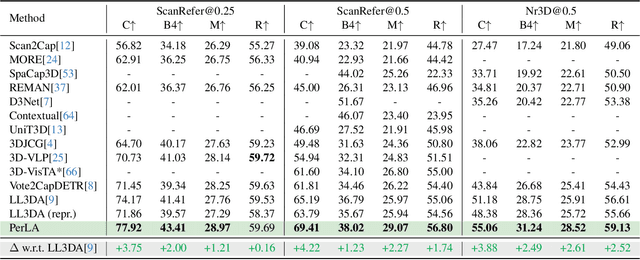

Abstract:Enabling Large Language Models (LLMs) to understand the 3D physical world is an emerging yet challenging research direction. Current strategies for processing point clouds typically downsample the scene or divide it into smaller parts for separate analysis. However, both approaches risk losing key local details or global contextual information. In this paper, we introduce PerLA, a 3D language assistant designed to be more perceptive to both details and context, making visual representations more informative for the LLM. PerLA captures high-resolution (local) details in parallel from different point cloud areas and integrates them with (global) context obtained from a lower-resolution whole point cloud. We present a novel algorithm that preserves point cloud locality through the Hilbert curve and effectively aggregates local-to-global information via cross-attention and a graph neural network. Lastly, we introduce a novel loss for local representation consensus to promote training stability. PerLA outperforms state-of-the-art 3D language assistants, with gains of up to +1.34 CiDEr on ScanQA for question answering, and +4.22 on ScanRefer and +3.88 on Nr3D for dense captioning.\url{https://gfmei.github.io/PerLA/}
CaLa: Complementary Association Learning for Augmenting Composed Image Retrieval
May 29, 2024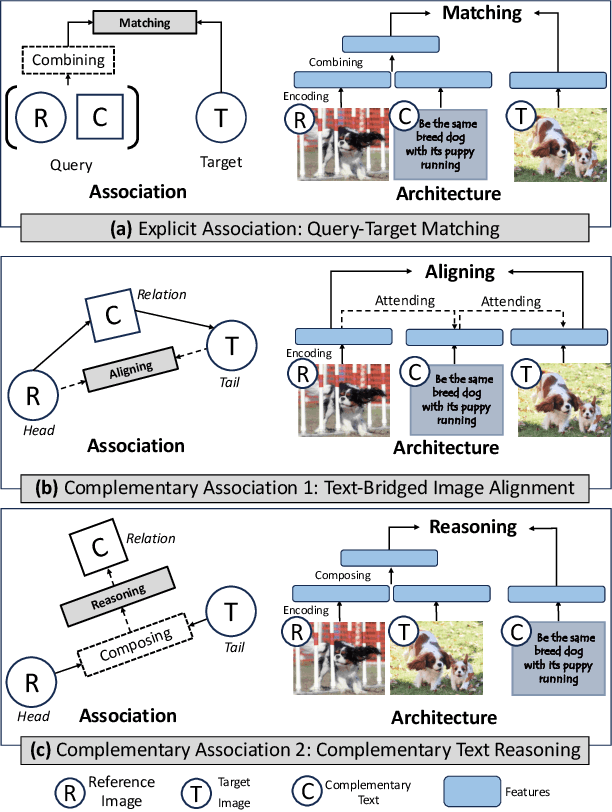
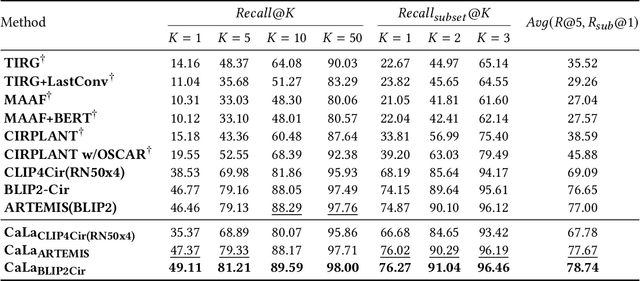
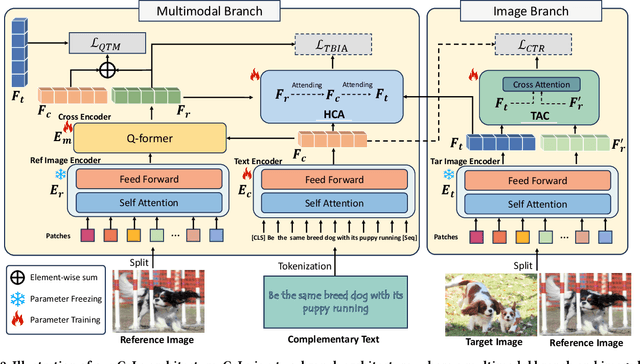
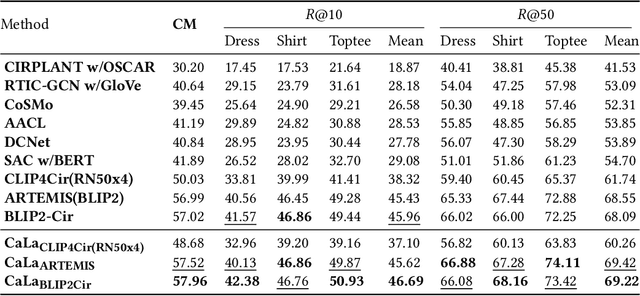
Abstract:Composed Image Retrieval (CIR) involves searching for target images based on an image-text pair query. While current methods treat this as a query-target matching problem, we argue that CIR triplets contain additional associations beyond this primary relation. In our paper, we identify two new relations within triplets, treating each triplet as a graph node. Firstly, we introduce the concept of text-bridged image alignment, where the query text serves as a bridge between the query image and the target image. We propose a hinge-based cross-attention mechanism to incorporate this relation into network learning. Secondly, we explore complementary text reasoning, considering CIR as a form of cross-modal retrieval where two images compose to reason about complementary text. To integrate these perspectives effectively, we design a twin attention-based compositor. By combining these complementary associations with the explicit query pair-target image relation, we establish a comprehensive set of constraints for CIR. Our framework, CaLa (Complementary Association Learning for Augmenting Composed Image Retrieval), leverages these insights. We evaluate CaLa on CIRR and FashionIQ benchmarks with multiple backbones, demonstrating its superiority in composed image retrieval.
Beyond Known Clusters: Probe New Prototypes for Efficient Generalized Class Discovery
Apr 13, 2024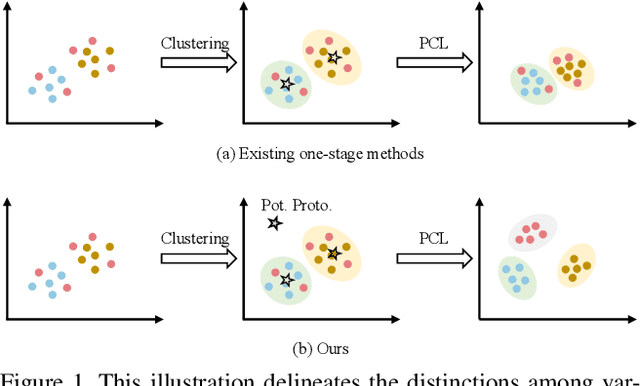
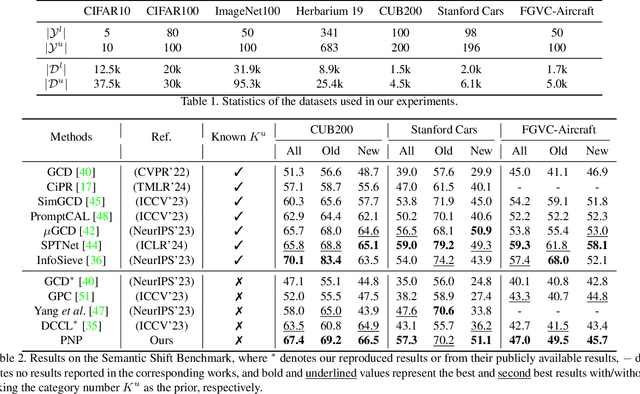


Abstract:Generalized Class Discovery (GCD) aims to dynamically assign labels to unlabelled data partially based on knowledge learned from labelled data, where the unlabelled data may come from known or novel classes. The prevailing approach generally involves clustering across all data and learning conceptions by prototypical contrastive learning. However, existing methods largely hinge on the performance of clustering algorithms and are thus subject to their inherent limitations. Firstly, the estimated cluster number is often smaller than the ground truth, making the existing methods suffer from the lack of prototypes for comprehensive conception learning. To address this issue, we propose an adaptive probing mechanism that introduces learnable potential prototypes to expand cluster prototypes (centers). As there is no ground truth for the potential prototype, we develop a self-supervised prototype learning framework to optimize the potential prototype in an end-to-end fashion. Secondly, clustering is computationally intensive, and the conventional strategy of clustering both labelled and unlabelled instances exacerbates this issue. To counteract this inefficiency, we opt to cluster only the unlabelled instances and subsequently expand the cluster prototypes with our introduced potential prototypes to fast explore novel classes. Despite the simplicity of our proposed method, extensive empirical analysis on a wide range of datasets confirms that our method consistently delivers state-of-the-art results. Specifically, our method surpasses the nearest competitor by a significant margin of \textbf{9.7}$\%$ within the Stanford Cars dataset and \textbf{12$\times$} clustering efficiency within the Herbarium 19 dataset. We will make the code and checkpoints publicly available at \url{https://github.com/xjtuYW/PNP.git}.
Dual Relation Alignment for Composed Image Retrieval
Sep 05, 2023



Abstract:Composed image retrieval, a task involving the search for a target image using a reference image and a complementary text as the query, has witnessed significant advancements owing to the progress made in cross-modal modeling. Unlike the general image-text retrieval problem with only one alignment relation, i.e., image-text, we argue for the existence of two types of relations in composed image retrieval. The explicit relation pertains to the reference image & complementary text-target image, which is commonly exploited by existing methods. Besides this intuitive relation, the observations during our practice have uncovered another implicit yet crucial relation, i.e., reference image & target image-complementary text, since we found that the complementary text can be inferred by studying the relation between the target image and the reference image. Regrettably, existing methods largely focus on leveraging the explicit relation to learn their networks, while overlooking the implicit relation. In response to this weakness, We propose a new framework for composed image retrieval, termed dual relation alignment, which integrates both explicit and implicit relations to fully exploit the correlations among the triplets. Specifically, we design a vision compositor to fuse reference image and target image at first, then the resulted representation will serve two roles: (1) counterpart for semantic alignment with the complementary text and (2) compensation for the complementary text to boost the explicit relation modeling, thereby implant the implicit relation into the alignment learning. Our method is evaluated on two popular datasets, CIRR and FashionIQ, through extensive experiments. The results confirm the effectiveness of our dual-relation learning in substantially enhancing composed image retrieval performance.
Towards Unified Text-based Person Retrieval: A Large-scale Multi-Attribute and Language Search Benchmark
Jun 06, 2023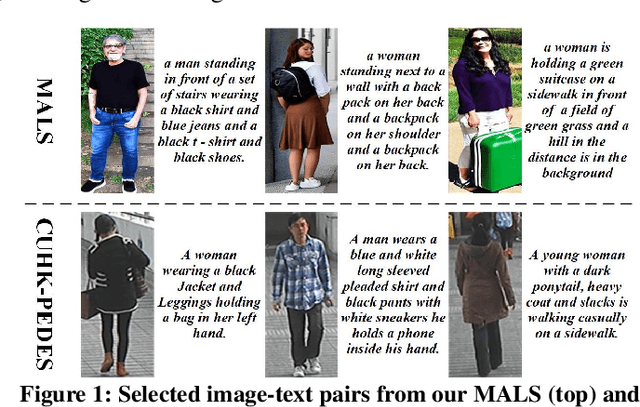

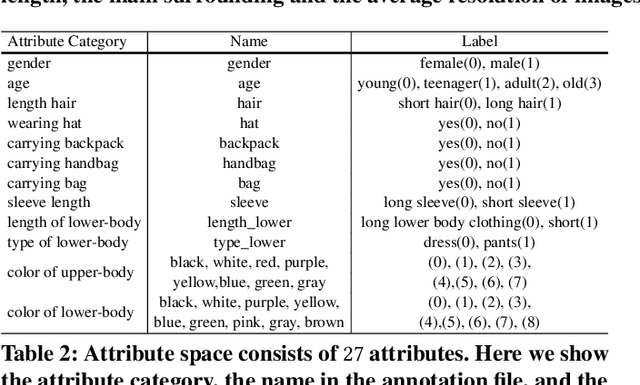

Abstract:In this paper, we introduce a large Multi-Attribute and Language Search dataset for text-based person retrieval, called MALS, and explore the feasibility of performing pre-training on both attribute recognition and image-text matching tasks in one stone. In particular, MALS contains 1,510,330 image-text pairs, which is about 37.5 times larger than prevailing CUHK-PEDES, and all images are annotated with 27 attributes. Considering the privacy concerns and annotation costs, we leverage the off-the-shelf diffusion models to generate the dataset. To verify the feasibility of learning from the generated data, we develop a new joint Attribute Prompt Learning and Text Matching Learning (APTM) framework, considering the shared knowledge between attribute and text. As the name implies, APTM contains an attribute prompt learning stream and a text matching learning stream. (1) The attribute prompt learning leverages the attribute prompts for image-attribute alignment, which enhances the text matching learning. (2) The text matching learning facilitates the representation learning on fine-grained details, and in turn, boosts the attribute prompt learning. Extensive experiments validate the effectiveness of the pre-training on MALS, achieving state-of-the-art retrieval performance via APTM on three challenging real-world benchmarks. In particular, APTM achieves a consistent improvement of +6.60%, +7.39%, and +15.90% Recall@1 accuracy on CUHK-PEDES, ICFG-PEDES, and RSTPReid datasets by a clear margin, respectively.
Multimodal Learning for Non-small Cell Lung Cancer Prognosis
Nov 07, 2022Abstract:This paper focuses on the task of survival time analysis for lung cancer. Although much progress has been made in this problem in recent years, the performance of existing methods is still far from satisfactory. Traditional and some deep learning-based survival time analyses for lung cancer are mostly based on textual clinical information such as staging, age, histology, etc. Unlike existing methods that predicting on the single modality, we observe that a human clinician usually takes multimodal data such as text clinical data and visual scans to estimate survival time. Motivated by this, in this work, we contribute a smart cross-modality network for survival analysis network named Lite-ProSENet that simulates a human's manner of decision making. Extensive experiments were conducted using data from 422 NSCLC patients from The Cancer Imaging Archive (TCIA). The results show that our Lite-ProSENet outperforms favorably again all comparison methods and achieves the new state of the art with the 89.3% on concordance. The code will be made publicly available.
DeepMMSA: A Novel Multimodal Deep Learning Method for Non-small Cell Lung Cancer Survival Analysis
Jun 12, 2021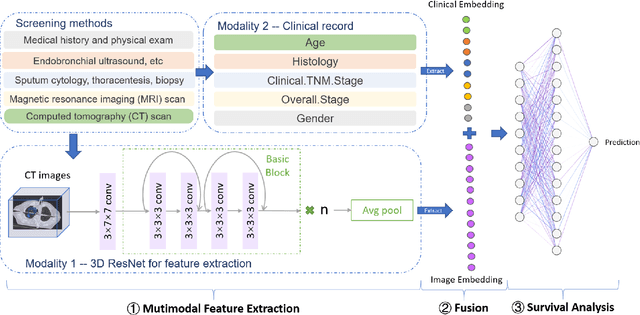
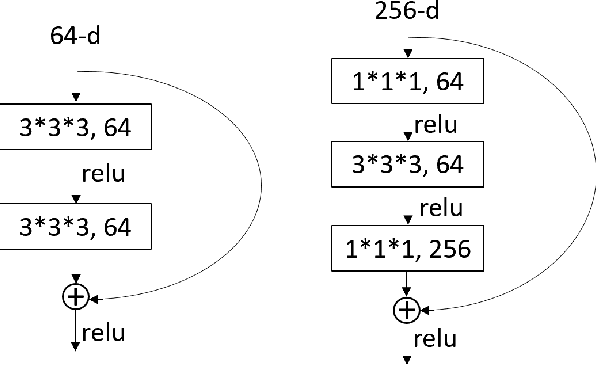
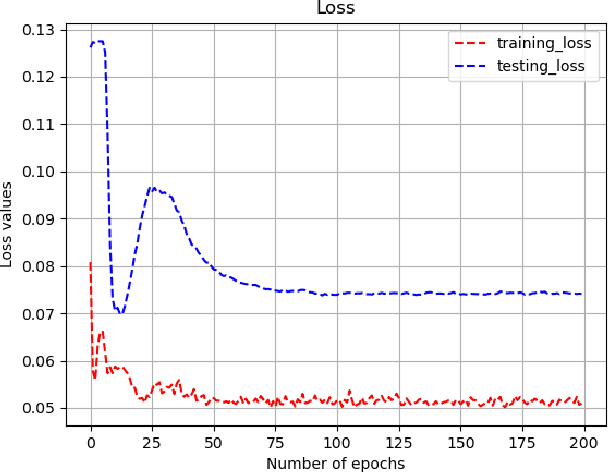
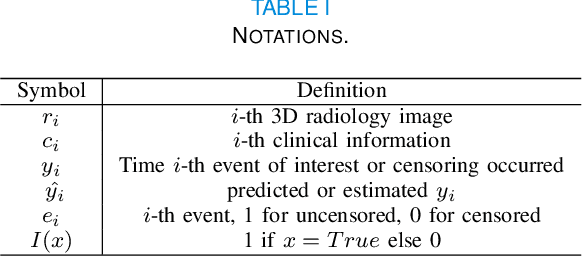
Abstract:Lung cancer is the leading cause of cancer death worldwide. The critical reason for the deaths is delayed diagnosis and poor prognosis. With the accelerated development of deep learning techniques, it has been successfully applied extensively in many real-world applications, including health sectors such as medical image interpretation and disease diagnosis. By combining more modalities that being engaged in the processing of information, multimodal learning can extract better features and improve predictive ability. The conventional methods for lung cancer survival analysis normally utilize clinical data and only provide a statistical probability. To improve the survival prediction accuracy and help prognostic decision-making in clinical practice for medical experts, we for the first time propose a multimodal deep learning method for non-small cell lung cancer (NSCLC) survival analysis, named DeepMMSA. This method leverages CT images in combination with clinical data, enabling the abundant information hold within medical images to be associate with lung cancer survival information. We validate our method on the data of 422 NSCLC patients from The Cancer Imaging Archive (TCIA). Experimental results support our hypothesis that there is an underlying relationship between prognostic information and radiomic images. Besides, quantitative results showing that the established multimodal model can be applied to traditional method and has the potential to break bottleneck of existing methods and increase the the percentage of concordant pairs(right predicted pairs) in overall population by 4%.
 Add to Chrome
Add to Chrome Add to Firefox
Add to Firefox Add to Edge
Add to Edge